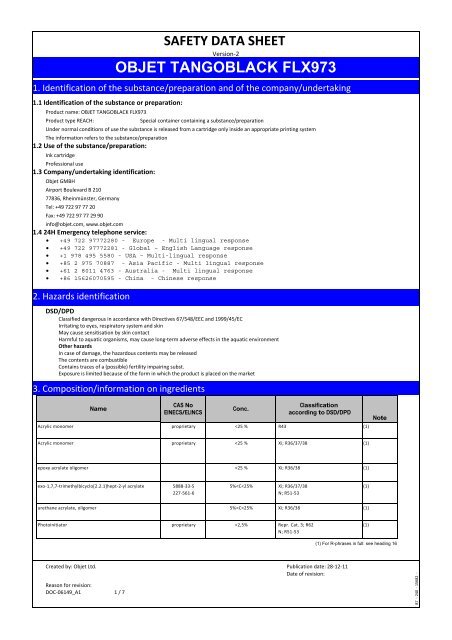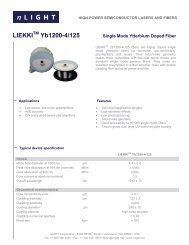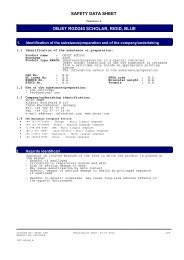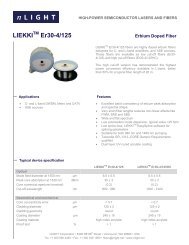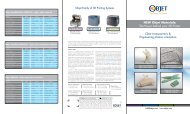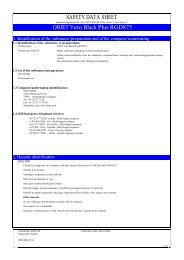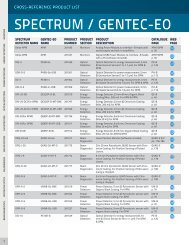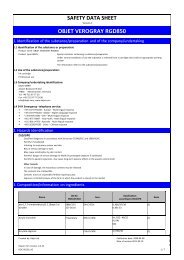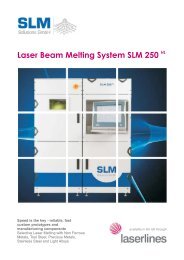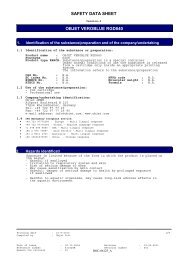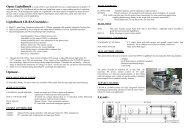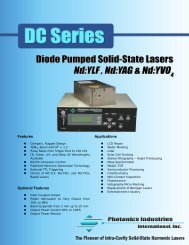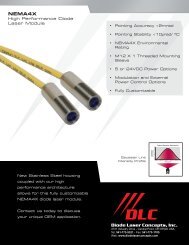OBJET TANGOBLACK FLX973 - Laser Lines Ltd.
OBJET TANGOBLACK FLX973 - Laser Lines Ltd.
OBJET TANGOBLACK FLX973 - Laser Lines Ltd.
Create successful ePaper yourself
Turn your PDF publications into a flip-book with our unique Google optimized e-Paper software.
SAFETY DATA SHEETVersion‐2<strong>OBJET</strong> <strong>TANGOBLACK</strong> <strong>FLX973</strong>1. Identification of the substance/preparation and of the company/undertaking1.1 Identification of the substance or preparation:Product name: <strong>OBJET</strong> <strong>TANGOBLACK</strong> <strong>FLX973</strong>Product type REACH:Special container containing a substance/preparationUnder normal conditions of use the substance is released from a cartridge only inside an appropriate printing systemThe information refers to the substance/preparation1.2 Use of the substance/preparation:Ink cartridgeProfessional use1.3 Company/undertaking identification:Objet GMBHAirport Boulevard B 21077836, Rheinmünster, GermanyTel: +49 722 97 77 20Fax: +49 722 97 77 29 90info@objet.com, www.objet.com1.4 24H Emergency telephone service:• +49 722 97772280 - Europe - Multi lingual response• +49 722 97772281 - Global – English Language response• +1 978 495 5580 - USA – Multi-lingual response• +85 2 975 70887 - Asia Pacific - Multi lingual response• +61 2 8011 4763 - Australia - Multi lingual response• +86 15626070595 - China - Chinese response2. Hazards identificationDSD/DPDClassified dangerous in accordance with Directives 67/548/EEC and 1999/45/ECIrritating to eyes, respiratory system and skinMay cause sensitisation by skin contactHarmful to aquatic organisms, may cause long‐term adverse effects in the aquatic environmentOther hazardsIn case of damage, the hazardous contents may be releasedThe contents are combustibleContains traces of a (possible) fertility impairing subst.Exposure is limited because of the form in which the product is placed on the market3. Composition/information on ingredientsNameCAS NoEINECS/ELINCSConc.Classificationaccording to DSD/DPDAcrylic monomer proprietary
4. First aid measures4.1 After inhalation:Remove the victim into fresh airRespiratory problems: consult a doctor/medical service4.2 Skin contact:Wash immediately with lots of water4.3 Eye contact:Soap may be usedTake victim to a doctor if irritation persistsRinse immediately with plenty of waterDo not apply neutralizing agents<strong>OBJET</strong> <strong>TANGOBLACK</strong> <strong>FLX973</strong>Take victim to an ophthalmologist if irritation persists4.4 After ingestion:Rinse mouth with waterImmediately after ingestion: give lots of water to drinkDo not induce vomitingConsult a doctor/medical service if you feel unwell5. Fire‐fighting measures5.1 Suitable extinguishing media:Water sprayAFFF foamBC powderCarbon dioxide5.2 Unsuitable extinguishing media:No unsuitable extinguishing media known5.3 Special exposure hazards:Heating increases the fire hazardOn burning: release of toxic and corrosive gases/vapours (nitrous vapours, carbon monoxide ‐ carbon dioxide) and formation of small quantities ofphosphorus oxides5.4 Instructions:If exposed to fire cool the closed containers by spraying with waterDilute toxic gases with water sprayTake account of environmentally hazardous firefighting waterUse water moderately and if possible collect or contain it5.5 Special protective equipment for fire‐fighters:GlovesFace‐shieldProtective clothingHeat/fire exposure: compressed air/oxygen apparatus6. Accidental release measures6.1 Personal precautions:See heading 8.26.2 Environmental precautions:Dam up the liquid spillAccidental release of the contents:Prevent soil and water pollutionPrevent spreading in sewersSee heading 13DOC‐06149_A1 2 / 7
<strong>OBJET</strong> <strong>TANGOBLACK</strong> <strong>FLX973</strong>6.3 Methods for cleaning up:Take up liquid spill into absorbent material, e.g.: sandScoop absorbed substance into closing containersCarefully collect the spill/leftoversClean contaminated surfaces with an excess of waterWash clothing and equipment after handling7. Handling and storage7.1 Handling:Keep away from naked flames/heatKeep container tightly closedAccidental release of the contents: observe very strict hygiene ‐ avoid contactDo not discharge the waste into the drain7.2 Storage:Safe storage requirements:Store in a dry areaStore in a dark areaVentilation at floor levelStore at room temperatureKeep out of direct sunlightMeet the legal requirementsStorage temperature: 15 ‐ 25 °CShipment temperature (up to 5 weeks): ‐20/50 °CKeep away from:7.3 Specific use(s):See information supplied by the manufacturer for the identified use(s)8. Exposure controls/Personal protection8.1 Exposure limit values:8.1.1 Occupational exposure:If limit values are applicable and available these will be listed below.8.1.2 Sampling methods:Product name Test Number Sampling method RemarksNo data available8.2 Exposure controls:8.2.1 Occupational exposure controls:Accidental release of the contents: carry operations in the open/under local exhaust/ventilation or with respiratory protectionPersonal protective equipment:a) Respiratory protection:Not required for normal conditions of useAccidental release of the contents:Insufficient ventilation: wear respiratory protectionb) Hand protection:Not required for normal conditions of useAccidental release of the contents: Glovesc) Eye protection:Not required for normal conditions of useAccidental release of the contents: Face shieldd) Skin protection:Not required for normal conditions of useAccidental release of the contents: Protective clothing8.2.2 Environmental exposure controls:See headings 6.2, 6.3 and 139. Physical and chemical propertiesDOC‐06149_A1 3 / 7
9.1 General information:<strong>OBJET</strong> <strong>TANGOBLACK</strong> <strong>FLX973</strong>Physical formOdourColour9.2 Important health, safety and environmental information:ink cartridgeThe contents are: liquidThe contents: mid odourThe contents: black9.3 Other information:Flashpoint > 100 °C10. Stability and reactivity10.1 Conditions to avoid:Possible fire hazardheat sourcesStabilityUnstable on exposure to heatUnstable on exposure to lightReactionsAfter destruction: polymerizes on exposure to light10.2 Materials to avoid:10.3 Hazardous decomposition products:On burning: release of toxic and corrosive gases/vapours (nitrous vapours, carbon monoxide ‐ carbon dioxide) and formation of small quantities of phosphorusoxides.11. Toxicological information11.1 Acute toxicity:PhotoinitiatorLD50 oral (rat)> 2000 mg/kgexo‐1,7,7‐trimethylbicyclo[2.2.1]hept‐2‐yl acrylateLD50 oral (rat)LD50 dermal (rabbit)4890 mg/kg> 5000 mg/kgAcrylic monomerLD50 oral (rat)> 2000 mg/kg11.2 Chronic toxicity:Not listed in carcinogenicity class (IARC,EC,TLV,MAK)Not listed in mutagenicity class (EC,MAK)Contains traces of a (possible) fertility impairing subst.PhotoinitiatorEC repr cat 3CLP repr cat category 211.3 Acute effects/symptoms:Inhalation:Irritation of the respiratory tractIrritation of the nasal mucous membranesSkin contact:Tingling/irritation of the skinEye contact:Irritation of the eye tissueIngestion:DOC‐06149_A1 4 / 7
<strong>OBJET</strong> <strong>TANGOBLACK</strong> <strong>FLX973</strong>Ingestion:No data available11.4 Chronic effects:ON CONTINUOUS/REPEATED EXPOSURE/CONTACT: Skin rash/inflammation12. Ecological information12.1 Ecotoxicity:PhotoinitiatorLC50 fishesspecies Value Duration (h) RemarksORYZIAS LATIPES 1 ‐ 10 mg/l 48 h12.2 Mobility:Solubility in/reaction with waterInsoluble in water12.3 Persistence and degradability:12.4 Bioaccumulative potential:12.5 Results of PBT assessment:Not applicable, based on available data12.6 Other adverse effects:Not dangerous for the ozone layer (1999/45/EC)13. Disposal considerations13.1 Provisions relating to waste:Waste material code (Directive 2008/98/EC, decision 2001/118/EC)08 03 12* : waste ink containing dangerous substancesDepending on branch of industry and production process, also other EURAL codes may be applicableHazardous waste according to Directive 2008/98/EC13.2 Disposal methods:Refer to manufacturer/supplier for information on recovery/ recyclingDo not landfillRemove waste in accordance with local and/or national regulationsDo not discharge into drains or the environment13.3 Packaging/Container:No available data14. Transport informationADRTransportUN number ‐ClassPacking groupHazard identification numberClassification codeLabelsEnvironmentally hazardous substance markNot subjectIIRIDTransportUN numberClassPacking groupClassification codeNot subjectDOC‐06149_A1 5 / 7
<strong>OBJET</strong> <strong>TANGOBLACK</strong> <strong>FLX973</strong>LabelsEnvironmentally hazardous substance markADNRTransportUN numberClassPacking groupClassification codeLabelsEnvironmentally hazardous substance markNot subjectIMOTransportNot subjectUN number ‐ClassPacking groupLabelsMarine pollutantEnvironmentally hazardous substance markICAOTransportNot subjectUN number ‐ClassPacking groupLabelsMarine pollutantEnvironmentally hazardous substance mark15. Regulatory information15.1 EU Legislation:DSD/DPDClassification according to directives 67/548/EEC, 1999/45/EC and 2006/8/ECIrritantContains: Acrylic monomerR-phrases36/37/38 Irritating to respiratory system and skin43 May cause sensitisation by skin contact52/53 Harmful to aquatic organisms, may cause long‐term adverse effects in the aquatic environmentS-phrases24 Avoid contact with skin35 This material and its container must be disposed of in a safe way37 Wear suitable gloves61 Avoid release to the environment. Refer to special instructions/safety data sheets.DOC‐06149_A1 6 / 7
<strong>OBJET</strong> <strong>TANGOBLACK</strong> <strong>FLX973</strong>15.2 National provisions:GermanyTA‐Luftexo‐1,7,7‐trimethylbicyclo[2.2.1]hept‐2‐yl acrylate: TA‐Luft Klasse 5.2.5/IWGK 316. Other informationClassification water polluting based on the components in compliance with Verwaltungsvorschriftwassergefährdender Stoffe (VwVwS) of 27 July 2005 (Anhang 4)The information provided on this SDS is correct to the best of our knowledge, information and belief at the date of its publication. The information given isdesigned only as guidance for safe handling, use, processing, storage, transportation, disposal and release and is not to be considered as a warranty or qualityspecification. The information relates only to the specific material designated and may not be valid for such material used in combination with any othermaterial or in any process, unless specified in the text.(*) = INTERNAL CLASSIFICATION (NFPA)PBT-substances = persistent, bioaccumulative and toxic substancesDSDDPDDangerous Substance DirectiveDangerous Preparation DirectiveFull text of any R‐phrases referred to under headings 2 and 3:R36/37/38 Irritating to eyes, respiratory system and skinR36/38 Irritating to eyes and skin.R43May cause sensitisation by skin contactR51/53 Toxic to aquatic organisms, may cause long‐term adverse effects in the aquatic environmentR52/53 Harmful to aquatic organisms, may cause long‐term adverse effects in the aquatic environmentR62Possible risk of impaired fertilityDOC‐06149_A1 7 / 7


